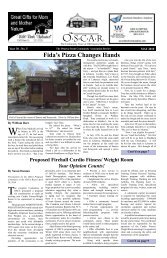You also want an ePaper? Increase the reach of your titles
YUMPU automatically turns print PDFs into web optimized ePapers that Google loves.
The th Page 24 OSCAR - OUR 37 YEAR<br />
July 2010<br />
BACKYARD NATURALIST<br />
Can You Spot a Bat?<br />
by Linda Burr<br />
One summer day, my daughter and I found a small bat curled up in<br />
an old willow stump at Windsor Park. We peered in amazement<br />
at its little furry body, which seemed fragile and mysterious. Bats<br />
are secretive creatures, and it’s a rare event to see one during the daytime.<br />
This summer, when you’re out in the neighbourhood at dusk, look around<br />
and see if you can spot a fluttering bat.<br />
There are about six species of bats known to occur regularly in the<br />
<strong>Ottawa</strong> area. Two species come into more frequent contact with humans<br />
because they regularly make use of buildings: Big Brown Bats and Little<br />
Brown Bats. In the spring, these bats leave their winter hibernation sites<br />
and seek out smaller summer roosts. Attics of houses make ideal nursery<br />
colonies, where the females give birth to one baby (occasionally twins),<br />
born between late May and early July. These nursery colonies may be<br />
used year after year, because the bats like to return to the places they were<br />
born.<br />
Many people are afraid of bats, but once you know more about them,<br />
you’ll see there is nothing to fear. In fact, bats need our good will more<br />
than ever. If you find a bat flying around inside your home or cottage this<br />
summer, please don’t kill it. A much easier solution to get rid of the bat<br />
is to simply open a window, turn on the lights, and let the bat find its way<br />
out. Contrary to popular belief, bats can see quite well, and they can find<br />
an opening such as a window fairly easily.<br />
Cottagers and home-owners may discover bats roosting in their attics,<br />
and decide to evict them. The best plan, if bats must be evicted, is to wait<br />
until fall, when the bats depart, and seal up the entrances so they cannot<br />
get back in. If you do find a bat, don’t try to touch it or pick it up. Bats can<br />
carry rabies, and although rabies is very rare in bats, it’s better to play it<br />
safe.<br />
Bats are an important part of the delicate balance of nature, but<br />
we don’t always appreciate them or the role they play because of their<br />
secretive nighttime habits. All the bat species in our region feed on insects<br />
and consume many flying insects each night. Without predators to eat<br />
them, these bugs could become a serious problem for us.<br />
It is feared that many bats died off during the past winter from a<br />
condition that has bat scientists puzzled. The first case in Ontario of bats<br />
with “white nose syndrome” was confirmed last March from a hibernation<br />
cave in the Bancroft-Minden area. The syndrome gets its name from a<br />
white fungus that grows on the affected bats’ noses and wings during<br />
hibernation. The condition was first found on bats in New York State in<br />
2006, and has since spread throughout the northeastern US, and has now<br />
reached Canada. Its cause is still not known, but it has been responsible<br />
for the deaths of hundreds of thousands of bats so far in the US.<br />
If you do catch a glimpse of bats this summer, count yourself lucky –<br />
because there are probably fewer bats than ever before.<br />
Linda Burr lives in <strong>Old</strong> <strong>Ottawa</strong> <strong>South</strong> and is a biologist and avid<br />
backyard naturalist.










